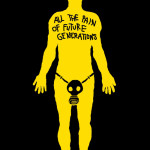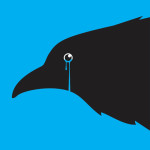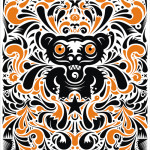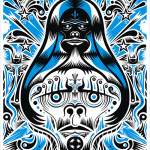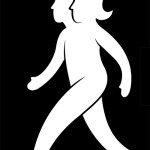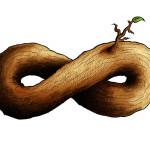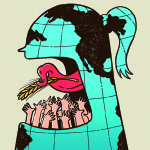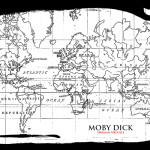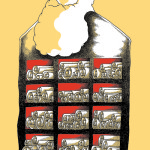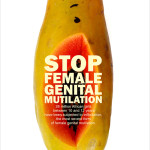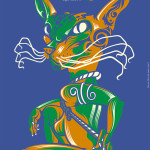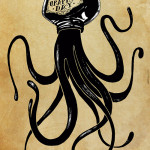There’s no better way to start the new year than to share with you the extraordinary work of our new Poster Master, the Mexican designer and illustrator Elmer Sosa.
Elmer studied design at the IESAC-BUAP, where he currently works as the head of the graphic design school, and he obtained an honorific grade from the University of Las Villas, Santa Clara in Cuba. He is the founder and creative director of Yomi Yomi Studio and works as an illustrator and political cartoonist for numerous national and International publications.
He’s posters and illustrations have earned him many awards, such as the Quorum Award in Mexico; the MUT ZUR WUT 2011 and 2012 in Heidelberg, Germany; First Place in The 5th International Poster Exhibition WALLS DOWN 2011-Faber Castell Category in Peru, First Place and Award of Excellence in the 2nd International Poster Contest CreaCartel 2011 in Venezuela and Honorable Mention in XVIII Graphic Humor Biennial in Cuba amongst others. He has acted as jury member and taught design workshops, and his work has been exhibited in countries all over the world, including Turkey, Russia, Iran, Belgium, Slovakia, China, Italy, Germany, Spain, Japan, the U.S., Cuba, France, Finland, Ucraine, Bolivia, Mexico, the Czech Republic, Peru, India and Venezuela.
Sosa’s Answers
We asked Elmer our “Poster Poster Questions” and this is what he had to say: Hello, I’m Elmer Sosa and we are going to talk a little about the poster.
1. What does the poster mean to you and why do you design posters?
The poster for me is the heart of Graphic Design, in it you can show, apply and merge every single discipline that the graphic design proposes. Historically it has been said that the poster is one of the most efficient instruments of communication… I totally agree with that.
So far this is what the poster means for me, but I don’t want to waste the opportunity to explain what the poster is, quoting the words of one of the biggest Japanese graphic designers, Kazumasa Nagai. He explains “The poster design is the higher point in the work of a graphic designer, where form and a unique concept are mixed to give life to the poster”.
2. What would you say makes a good poster?
The concept is the vital part of a good poster; sail from a concept and you will find pure communication, and that’s basically the life’s objective of a poster, and not only of a poster, but of every design project. The form isn’t far behind from the concept; it has as much value. We always pursue an aesthetic result, but sometimes this is not for the best.
The formal election, I would say, is one of the most fun processes; thinking about your idea as a collage, a vector, an illustration, etc., is one of the most interesting challenges. Finding the shape of your concept.
3. What do you think is the role of the poster on the world today?
The role of the poster today, and always has been the same, to communicate in an efficient way. Most of the main objective of the poster is to show, using a piece of paper and -why not say so- a group of pixels, the ideology and voice of not only of the designer, but of all those who are in communion with the message that the poster delivers. It’s universal importance and temporality lies on this principle, that what we want to say is seen by the people, and they are able to make the message their own, share it, and in the best of cases, take action.
4. What is your typical design process for making a poster?
The beginning of the path should always start with the research about the subject, diving into the theoretical information and engaging in an iconographic revision of the graphic solutions that have previously been created about your topic is essential. This prevents us from falling into obviousness and recurrent ideas, which could be devastating.
A good time dedicated to the reflection about the subject to obtain a good concept to represent, acompanied by a pencil, a sketchbook, and the opinions of the people close to you about the topic is the method I follow. I always leaned to work with metaphors and the mixture of worlds. We have a bit of god; we create worlds and their inhabitants, and with this I always try to generate a different solution to what is established that surprises my client or my public.
We should always look for that which they don’t expect from you.. Sometimes that difference could be the representation style, the use of humor, or maybe the simplicity you use to solve the poster, without leaving aside the importance of the concept.
5. If you could chose a poster in history as your favourite, which one would it be and why?
“Victory” from Shigeo Fukuda was my door to discover poster design and from that poster I discovered all Fukuda’s work. Like me, people I admire have been also influenced by him. Those simple but impossible images, full of powerful concepts, that vertigo they create in your mind when you stand to observe one of his works, and the need see more is something I still feel when looking at his work.
The Russian Vladimir Chaïka, one of my favorite designers, said during one of his conferences: “Who has never wanted to design a poster following the Fukuda style at some point in their lives”. And I think many. He is completely right, definitely Fukuda is an important influence in my work.
6. What advice would you give to new designers who might want to become poster designers?
It is important to develop a wide visual culture. As communicators we need to know a little of every theme that our society is creating, from th local to theglobal, in order to have the basic weapons to give an accurate opinion through the poster.


